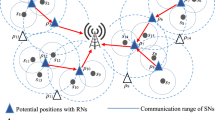Abstract
Individual sensors in wireless mobile sensor networks (MSNs) can move in search of coverage region for the sensing accuracy and for reaching the most efficient topology. Besides, sensors’ clustering is crucial for achieving an efficient network performance. Although MSNs have been an area of many research efforts in recent years, integrating the coverage problem of MSNs with the efficient routing requirement that will maximize the network lifetime is still missing. In this paper, we consider the coverage optimization problem where the location of a given number of mobile sensors needs to be re-decided such that the sensed data from the detected targets can be routed more efficiently to the sink and thus increasing the network lifetime. We formulate this NP-complete problem as a multi-objective optimization (MOO) problem, with two conflicting and correlated objectives; aiming at high coverage as well as longevity of network lifetime. The Non-Dominated Sorting Genetic Algorithm-II (NSGA-II) is utilized as a cluster-based routing protocol to tackle this MOO problem. Each round of the proposed NSGA-II based routing protocol creates a set of near-Pareto-optimal solutions containing a number of non-dominated solutions, in which the sink can pick up and distribute the one with high coverage to form the clustered routes. Heuristic operators are also proposed to enhance the quality of the solutions. Simulation results are provided to illustrate the effectiveness and performance of the proposed evolutionary algorithm.










Similar content being viewed by others
References
Aurenhammer F (1991) Voronoi diagrams—a survey of a fundamental geometric data structure. Comp Surveys 23:345–405
Bartolini N, Calamoneri T, Fusco EG, Massini A, Silvestri S (2008) Snap & spread: a self-deployment algorithm for mobile sensor networks. In: Proc IEEE DCOSS, pp 451–456
Coello CAC, Lamont GB, Veldhuizen DAV (2007) Evolutionary algorithms for solving multi-objective problems, 2nd edn. Springer, Berlin
Cortes J, Martinez S, Karatas T, Bullo F (2004) Coverage control for mobile sensing networks. Trans Robot Autom 20(2):243–255
Deb K, Pratap A, Agarwal S, Meyarivan T (2002) A fast and elitist multi-objective genetic algorithm: NSGA-II. Trans Evol Comput 6(2):182–197
Heinzelman WB, Chandrakasan AP, Balakrishnan H (2002) An application-specific protocol architecture for wireless microsensor networks. Trans Wirel Commun 1(4):660–670
Heo N, Varshney PK (2005) Energy-efficient deployment of intelligent mobile sensor networks. IEEE Tran Syst, Man, Cybern Part A: Syst Hum 35(1):78–92
Iyengar SS, Wu H, Balakrishnan N, Chang SY (2007) Biologically inspired cooperative routing for wireless mobile sensor networks. IEEE Syst J 1(1):29–37
Jourdan DB, de Weck OL (2004b) Multi-objective genetic algorithm for the automated planning of a wireless sensor network to monitor a critical facility. In: Proc SPIE, vol. 5403, pp 565–575
Jourdan DB, deWeck OL (2004a) Layout optimization for a wireless sensor network using a multi-objective genetic algorithm. In: Proceedings of the IEEE Veh Tech, vol. 5, pp 2466–2470
Khalil EA, Attea BA (2011) Energy-aware evolutionary routing protocol for dynamic clustering of wireless sensor networks. Swarm Evol Comput 1(4):195–203
Konstantinidis A, Yang K, Zhang Q, Zeinalipour-Yazti D (2009) A multi-objective evolutionary algorithm for the deployment and power assignment problem in wireless sensor networks. Comput Netw 54(6):960–976
Konstantinidis A, Charalambous C, Zhou A, Zhang Q (2010) Multi-objective mobile agent-based sensor network routing using MOEA/D. In: Proc CEC, pp 1–8
Li X, Frey H, Santoro N, Stojmenovic I (2009) Focused-coverage by mobile sensor networks. In: Proc Mobile Adhoc and Sensor Systems, pp 466–475
Martins FVC, Carrano EG, Wanner EF, Takahashi RHC, Mateus GR (2011) A hybrid multiobjective evolutionary approach for improving the performance of wireless sensor networks. IEEE Sens J 11(3):545–554
Meguerdichian S, Koushanfar F, Potkonjak M, Srivastava MB (2001b) Coverage problems in wireless ad-hoc sensor network. In: Proc IEEE Infocom, vol. 3, pp 1380–1387
Meguerdichian S, Koushanfar F, Qu G, Potkonjak M (2001a) Exposure in wireless ad-hoc sensor networks. In: Proc ACM MobiCom, pp 139–150
Özdemir S, Attea BA, Khalil ÖA (2012) Multi-objective evolutionary algorithm based on decomposition for energy efficient coverage in wireless sensor networks. Wirel Pers Commun. doi:10.1007/s11277-012-0811-3
Rajagopalan R, Mohan CK, Varshney PK, Mehrotra K (2005) Multiobjective mobile agent routing in wireless sensor networks. In: Proc IEEE CEC, vol. 2, pp 1730–1737
Sibley GT, Rahimi MH, Sukhatme GS (2002) Robomote: a tiny mobile robot platform for large- scale sensor networks. Proc IEEE Int’l Conf Robot Autom 2:1143–1148
Srinivas N, Deb K (1994) Multi-objective function optimization using non-dominated sorting genetic algorithms. Evol Comput 2(3):221–248
Suen Y (2002) A Genetic-algorithm based mobile sensor network deployment algorithm. Retrieved on Nov. 10, 2012, from Univ of Texas ECE Dept Website: http://hostdb.ece.utexas.edu/~bevans/courses/ee382c/projects/spring04/YuklaiSuen/FinalReport.pdf
Wang G, Cao G, La Porta T (2004) Movement-assisted sensor deployment. Proc IEEE INFOCOM 4:2469–2479
Wang G, Cao G, La Porta T (2004) Movement-assisted sensor deployment. IEEE Trans Mobi Comput 5(6):640–652
Wang G, Cao G, Berman P, La Porta T (2007) A bidding protocol for deploying mobile sensors. Trans Mobi Comput 6(6):563–576
Wu Q, Rao NSV, Iyengar SS, Vaishanavi VK, Qi H, Chakrabarty K (2004) On computing mobile agent routes for data fusion in distributed sensor networks. Trans Knowl Data Eng 16(6):740–753
Xiaoling W, Lei S, Jin W, Cho J, Lee S (2006) Energy-efficient deployment of mobile sensor networks by PSO. In: Proc APWeb, pp 373–382
Yang S, Li M, Wu J (2007) Scan-based movement-assisted sensor deployment methods in wireless sensor networks. IEEE Trans Para Dist Syst 18(9):1108–1121
Younis O, Krunz M, Ramasubramanian S (2006) Node clustering in wireless sensor networks: recent developments and deployment challenges. Network 20(3):20–25
Zhang Q, Li H (2007) MOEA/D: a multi-objective evolutionary algorithm based on decomposition. Trans Evol Comput 11(6):712–731
Zhuofan L, Zhang S, Cao J, Wang W, Wang J (2012) Minimizing movement for target coverage in mobile sensor networks. In: Proc ICDCSW, pp 194–200
Zitzler E (1999) Evolutionary algorithms for multi-objective optimization: methods and applications. Doctoral dissertation, Zurich, Switzerland: Swiss Federal Institute of Technology
Author information
Authors and Affiliations
Corresponding author
Additional information
Communicated by V. Loia.
Rights and permissions
About this article
Cite this article
Attea, B.A., Khalil, E.A. & Cosar, A. Multi-objective evolutionary routing protocol for efficient coverage in mobile sensor networks. Soft Comput 19, 2983–2995 (2015). https://doi.org/10.1007/s00500-014-1462-y
Published:
Issue Date:
DOI: https://doi.org/10.1007/s00500-014-1462-y




